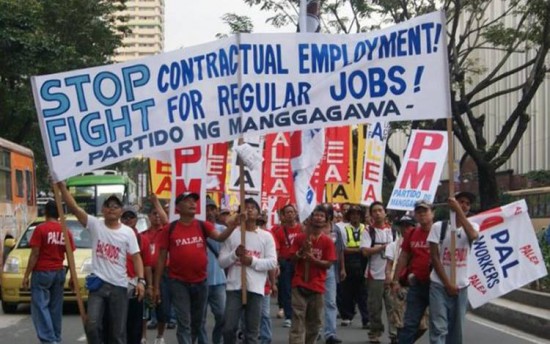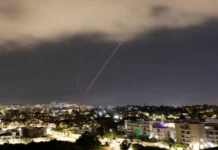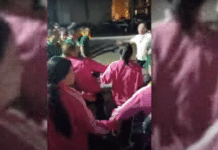Forced evictions, poverty wages and repression is the reality for millions
By a CWI correspondent in Philippines
There is a lot of hype about a Philippines ‘economic miracle’ and high GDP growth rates during the current Benigno Aquino presidency (since 2010). But this is nothing new. GDP grew at roughly the same rates under the previous Arroyo government, even after waves of corruption scandals and political crises that called her administration’s legitimacy into question. Countless governments and institutions like the World Bank have been harping on about the country’s economic growth since the 1970s, but rarely do they call our attention to the nature of that growth or the realities of growing inequality that GDP calculations too often gloss over.
What has changed is the increase in large-scale investments in speculative real estate and mineral extraction, and commercial-industrial zones where labour rights are weak or non-existant. These are taking up an increasing share of the country’s economy. The Aquino administration has leaped enthusiastically on the opportunity to vest ever more power in the hands of local and foreign capital and their government allies. Already attempts are underway to revise the constitution and invite new waves of trade liberalisation, deregulation, and privatisation.
Widening wealth gap
Aquino’s policies are faithful to the neoliberal template of those that came before him. Public investment in mega-infrastructure has grown while investment in social services (in real terms) has declined. More and more is forked out to corporations – with the government granting millions to guarantee their investments through so-called public-private partnership agreements – while wage rates stagnate and unemployment grows alongside GDP. The first quarter of 2013 saw the rate of Philippine GDP growth outpace that of China, but the previous year saw more than 800,000 farmers lose their livelihoods as well as fisher folk and unskilled labourers. About 26,000 professional, associate professional and technicians lost their jobs.
One reason for the contradiction is that the Philippine economy is still characterised by weak manufacturing and agricultural sectors, and growth is concentrated mainly in the service sector. This has benefited the capital Manila and a few urban centres like Cebu, but has widened the geographic and social inequalities, with only a minority of people benefitting from higher wages.
Income disparities in the Philippines are still among the highest in South East Asia. In 2009, the bottom 70 percent of Filipino households – some 65 million people – lived on roughly 104 pesos (US$2) a day or less, which is the World Bank’s international poverty line.
The net worth of the top 40 wealthiest Filipinos rose from US$27.8 billion in 2010 to 47.4 billion in 2012, a more than 40 percent increase. This is equivalent to over a fifth of GDP. The corporations of these 40 individuals control most of the major growth sectors in the Philippine economy – in real estate, ports, construction, trade, power, water, telecommunications, transport, mining, banking and finance, and the food and beverage industries.
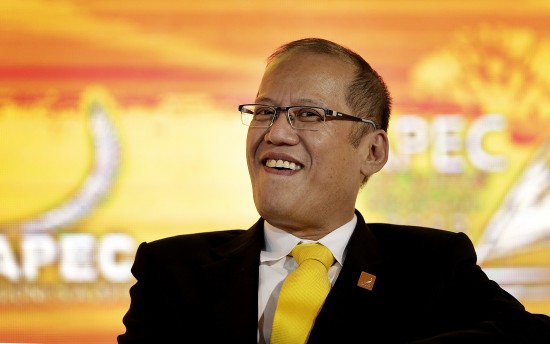
Poverty wages
Labour conditions are characterised by chronic insecurity through labour contractualisation, structural unemployment, low wages, and union repression. The real unemployment rate is one of the highest seen in decades: 7 percent according to government figures, but with other estimates citing 10.5 percent, or 4.4 million people, as a more realistic estimate, if we take discouraged and underemployed workers into account.
Real wages have stagnated amid inflation and rising costs of basic goods and services. The minimum wage is barely half of the estimated ‘living’ wage (US$23) for a family of five. The minimum wage of 446 pesos (US$9.9) a day rose by a mere 10 pesos in 2012 in Metro Manila or the National Capital Region (NCR) – where wages are already more than fifty per cent higher than those in the provinces. Daily basic pay rose by only 3.6 percent in the context of rising labour productivity, which increased by 5.3 percent between 2011-2012.
At US$279 a month, average wages in the Philippines are the third lowest among 72 countries in the world, surpassing only Tajikistan and Pakistan, according to the International Labour Organisation. Poverty is rising even in the ‘formal sector’ where precarious or temporary contracts are now the norm. The poverty rate stands at 43.2 percent for agricultural workers, 16.5 percent for industrial workers, and 11.1 percent for those in the service sector.
Despite the already low level of wages, the government is instituting a new two-tiered wage system composed of a mandatory floor wage – lower than the minimum wage – and wages determined by a worker’s ‘productivity’, which is to be set by the employers. Eleven out of sixteen of the country’s regions are already implementing the two-tiered wage system.
All this is compounded by rising costs of education and healthcare. Tuition fees in higher education have risen by an average 8.5 percent this year, while privatisation has made basic healthcare prohibitively expensive.
Price controls on basic commodities are negligible. 19.1 million families reported experiencing hunger from lack of income in 2011. Taken together, prices for basic commodities consumed by the bottom third of the population, including food and rice in particular, have risen by nearly 6 percent per year from 2003 to 2012, which is higher than the national average inflation.
Measures to ease poverty, including the government’s ‘flagship anti-poverty programme’ – Conditional Cash Transfers (CCTs), fail to deal with the real causes of poverty, and themselves involve debt burdens and are laden by debt and allegations of corruption. Funding for the CCT scheme will, in addition, start rolling back by 2015.
Slums and land grabs
There is a total absence of mass public housing. So the urban slum population has grown from 16.2 million in 1990 to 23.9 million in 2007. This means that 42.3 per cent of the urban population live in slum areas, and more than a quarter of people residing in Metro Manila, or 2.7 million people, live in informal settlements, according to government figures. Slums are often built on public but degraded land, in dumpsites, coastal zones, or major waterways and road networks – getting in the way of highly profitable commercial projects.
Attempts to relocate slum-dwellers through often violent demolitions have resulted in extreme hardship, with government resettlement sites far from places of work.
Essentially, one sees condominiums nobody can afford to buy in the middle of nowhere, while tens of thousands remain homeless and jobless, and informal settlements are demolished to pave way for new gated communities, shopping malls, mines, and casinos.
Workers’ rights under attack
Waves of neo-liberalisation and deregulation since the 1990s have led to a progressive weakening of union organisation in the Philippines. Only 10.6 percent of workers are members of unions or are covered by Collective Bargaining Agreements (CBA), and the level is even less for the service sector.
The Aquino administration has rejected calls for a minimal across-the-board minimum wage hike of 125 pesos (US$2.78), and one of the core objectives of government policy is to ensure “industrial peace” through strengthening “tripartism”. A law passed in 2013 makes it mandatory to resolve – or, in other words, quash – labour disputes, in what is essentially a call for unions to enter into forced conciliation with management. The law forces unions to enter into a 30-day pact with employers, and mandates them to comply with various requirements before filing a notice of strike.
Recent years have also seen a slew of labour rights violations. Occupational and basic health and safety regulations are poorly enforced, and a general atmosphere of fear and insecurity in the context of high unemployment has dampened labour resistance. An average of close to a hundred individual workers are sued every year under trumped-up criminal charges, employers regularly break collective bargaining provisions or prevent their workers from entering such agreements to begin with. Strikes and pickets are often met with preventive suspension, forced leave or dismissal, and police suppression.
Nevertheless there has been resistance. In 2012, workers at Filipinas Palmoil Plantation Inc. (FPPI) were receiving less than the minimum wage until the FPPI union organised close to a thousand workers in a strike. Similar strikes have been reported among workers of Express Coat Enterprises Inc. and workers in industrial zones.
These have been scattered and isolated for the most part, however, and while some attempts have been made, workers have not yet managed to unite or mount an effective political challenge with something like a national strike.
Perhaps the closest thing to this has been the Kilusang Mayo Uno (KMU or May First Movement), which aligns itself with the largest left political bloc in the country – the national democratic movement influenced by the Maoist Communist Party of the Philippines (CPP), which follows a ‘protracted people’s war’ strategy spear-headed by its armed wing, the New People’s Army (NPA). The CPP, however, has taken a sectarian stance toward what it perceives as ‘yellow’ unions, and its mistaken political perspective has seen it appeal to workers to abandon their workplaces to take up arms and join the NPA in the countryside.
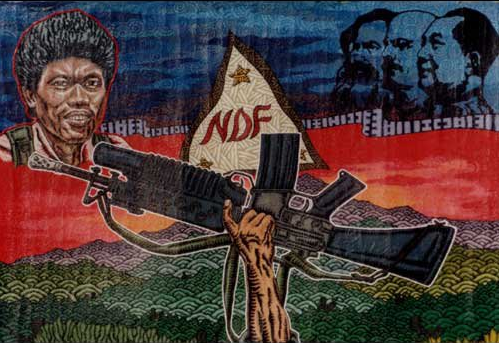
Splits and realignments on the left
The history of the Philippine left is a long and complex one, but some of the major left organisations can broadly be categorised according to their positions during the split of the CPP in the early 1990s.
Reaffirmists (RAs) – those who agreed with the call of the then CPP chairman, Jose Maria Sison, to ‘Reaffirm Our Basic Principles and Rectify Errors’ and continued to adhere to the Maoist conception of a protracted people’s war through the NPA. This was followed by a wave of persecutions and executions against former comrades who called themselves the Rejectionists (see below).
The CPP-NPA or the RAs adhere to a two-stage theory of revolution – a national democratic revolution followed by the socialist transition – based on their assessment of the Philippines as a ‘semi-feudal, semi-colonial’ society. The CPP organises among workers, peasants, indigenous peoples, and other social sectors through a variety of legal fronts under the National Democratic Front of the Philippines, which is by far the largest left bloc at present.
The RAs have a presence in activities on most issues of the day, and they are strongest among the youth in universities where they organise. But the past years have seen them make alliances with local rulers they perceive as ‘progressive’ or representing the ‘nationalist bourgeoisie’, while the base of the NPA has shrunk significantly from its peak in the late 1980s. Pockets of NPA activity are still to be found in the most economically depressed parts of the country but their numbers have dwindled to between 4,000 to 5,000 fighters, and the arrest of their top leaders this year has shaken them.
Apart from a few isolated bases in the countryside, overall the RAs have not gained the sympathy of broad sections of the working class, and with their sectarian stance toward other left groups, and during campaigns where CPP-aligned groups often seek to gain full control, it’s difficult not to see them as something of a cult. Given the nature of a guerrilla struggle, and the realities of repression by the state, methods of organisation tend to be hierarchical, bureaucratic and characterised by an almost militant disregard for intellectual thought, with orders passed down from above and little room for internal discussion or debate. Political slogans are recycled, and mass campaigns often boil down to little more than shouting matches against narrow political targets – individual politicians, President Aquino – without elevating this into a wider critique of the system as a whole.
Never is the word ‘capitalism’ or even ‘socialism’ openly stated – these are reserved for study groups among an indoctrinated ‘cadre’.
It can be argued, however, that there are signs of change, especially among younger activists seeking fresh perspectives. What the RAs lack above all is a political programme that inspires genuine hope, rooted in internal democracy (which will mean a break from its calcified leadership), and a radicalism measured not by the amount of violence it’s willing to use, but by its commitment to an independent struggle of and by the working class. The CPP’s internal politics are not as coherent as they would make it out to be, but any change can only come from a radical break from within.
Rejectionists (RJs) – Since the CPP split at the beginning of the ‘90s, the RJs have further splintered into numerous other factions, including Partido Lakas ng Masa, Sanlakas, Partido ng Manggawa, Bukluran ng Manggagawang Pilipino. These groups broadly share the analysis of the Philippines as a ‘semi-capitalist’ society, and they have a stronger orientation towards industrial workers.
Other groups formerly among the RJs, like Akbayan, have shifted radically to the right, and have since gone over to the Aquino administration, with their key members granted choice positions in the government bureaucracy.
Few left organisations openly declare themselves as Trotskyists. One exception would be the Revolutionary Workers’ Party, linked with the USFI, which is active in the southern province of Mindanao.
200 extrajudicial killings
State repression against the left and workers’ struggles has eased since the days of the Arroyo presidency, but this is relative.
Karapatan, a monitoring group, documents over 200 extra-judicial killings, 221 frustrated killings, 104 victims of torture, and more than 40,000 people displaced due to military operations since the start of Aquino’s presidency. Among these are many journalists, union leaders, and organisers or sympathisers of the left. Quite recently a student leader from the University of Mindanao was shot dead in an encounter with the Philippine military.
Impunity for the powerful and connected is still rife, and pending cases against corruption and political killings have stagnated, with no justice in sight and witnesses executed in broad daylight. Since 2010, four witnesses to the Maguindanao massacre (in which 58 people were abducted and killed by a local warlord) have been killed.
Despite the formidable obstacles and a complicated and fragmented situation within the left, the brutal reality of capitalism in the Philippines will create new opportunities in the coming years to rebuild and politically re-equip the workers’ movement with a genuine socialist analysis and alternative.

